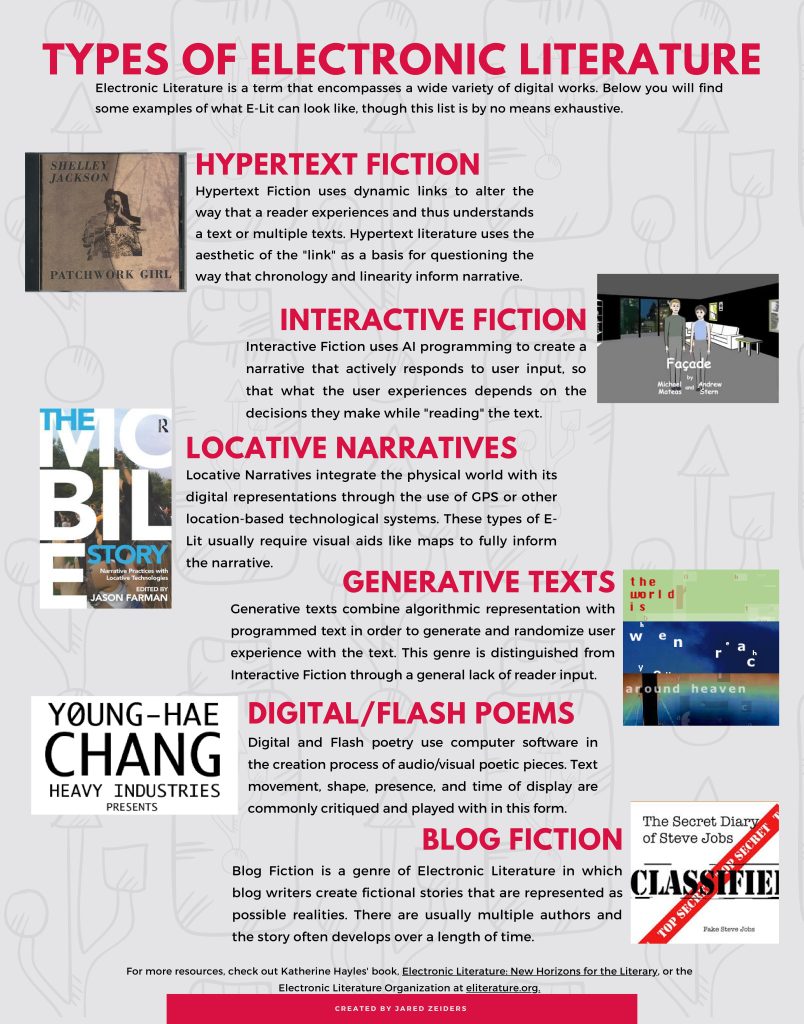Brent Ameneyro – DH E-lit Programs Assistant
One of the barriers I’ve encountered when introducing E-Lit to traditional writers is navigating the vast (and sometimes intimidating) landscape. To help with this challenge, I have curated a few resources to educate and inspire.
This is just a humble blog post and is not intended to replace the important scholarly work that has been conducted in this field. E-Lit has been around since the dawn of computer technology. As personal computers became more common in the 90s, E-Lit gained momentum with groundbreaking works like Shelley Jackson’s Patchwork Girl (1995), a continuation of Mary Shelley’s Frankenstein.
For more on E-Lit, visit the Electronic Literature Organization (ELO est. 1999): https://eliterature.org/. There you can discover the full history of E-Lit, several collections, information about the ELO conference, and much more.
UNDERSTANDING E-LIT
A work of electronic literature can be defined as “a construction whose literary aesthetics emerge from computation”, “work that could only exist in the space for which it was developed/written/coded—the digital space.”
To provide a basic understanding of the many forms of E-Lit, here is an informative flyer created by recent SDSU graduate Jared Zeiders:

OPERATING WITHIN LITERARY TRADITIONS
https://iloveepoetry.org/
Dr. Leonardo Flores has curated an impressive collection of E-Lit on this website. He includes definitions, scholarly sources, and links to creative works in a catalog that by itself conveys how E-Lit has carved out a place in the larger literary conversation: “This website contains over 700 entries on a variety of works of e-literature. The Resources menu has a few organized collections and the Categories pull down menu on the sidebar will lead to discovering works created with different technologies and in many different genres. There’s even a page dedicated to defining electronic poetry.”
At the most recent Living Writers event, Paisley Rekdal shared her E-Lit work with the audience. This piece includes hypertext and video poetry. This is a hybrid work that utilizes docu-poetics to inform, archive, and inspire. At the Living Writers event, Rekdal said that E-Lit is not all that different from traditional poetry: “At first this [E-Lit] would seem like something that’s very different from a textual book. But, actually, with a book of poetry there is something digital about that reading practice. When we go to a book of poetry, even though there is a material beginning middle and end, the reality is that…people kind of open up and dip in as they want. They don’t necessarily read in order. So, there’s something kind of amusing to me about creating this digital artifact that is in fact doing something that we already do with books of poetry…”
https://www.yhchang.com/
Young-hae Chang Heavy Industries started producing their exciting, fast-paced digital poems during the peak Adobe Flash days of the internet. Now, they have converted their work to video and have a rich catalog to enjoy. YHCHI directly acknowledges their place within the tradition of poetry with their piece titled “DAKOTA.” In her essay “Pacific Rim Digital Modernism: The Electronic Literature of Young-hae Chang Heavy Industries,” Dr. Jessica Pressman writes, “…the plot follows the opening of Pound’s first canto, which follows a section from Book XI of Homer’s Odyssey.”
A SELECTION OF WRITERS/ARTISTS
Mark Marino – http://markcmarino.com/wordpress/creative-works/
Marino experiments with many forms of E-Lit from interactive fiction to Twitter Bots.
Caitlin Fisher – http://caitlinfisher.ca/
Fisher creates, researches, and teaches immersive storytelling, augmented and virtual reality. She received the Vinaròs Prize for augmented reality poetry for one of the world’s first AR poems.
Erik Loyer – https://erikloyer.com/
Loyer defines his own work best: “I build apps and tools that help people make, tactile, emotional connections to challenging stories and ideas.”
Samantha Gorman – https://samanthagorman.net/
Gorman is known for projects that make critical, creative interventions in form/technology (e-readers, mobile VR, AR, machine learning, biometrics).
Ben Grosser – https://bengrosser.com/projects/
Grosser produces a wide range of E-Lit with many projects that focus on Social Media.
Stephanie Strickland – https://www.stephaniestrickland.com/
Strickland has published widely in both traditional poetry and digital poetry.
Jason Nelson – http://www.secrettechnology.com/
Nelson primarily produces video game poems and E-Lit that focuses on play and interactivity.
Tina Escaja (Alm@ Pérez) – https://proyecto.w3.uvm.edu//
Self-described “destrucvist/a cyber-poet@,” Escaja creates robots, electronic t-shirts, and many wildly innovative projects.
Loss Pequeño Glazier – http://writing.upenn.edu/epc/authors/glazier/
Glazier stands among literary figures at the “forefront of the digital poetics movement.” A “distinguished writer of electronic poetry as well as a critic”, according to N. Katherine Hayles.
SDSU TOOLS & RESOURCES
https://dhblog.sdsu.edu/dh-news/free-dh-tools – A list of free tools.
DH LibGuide – A curated introduction to digital humanities texts, methods, and projects.
Virtual Tutorials – A growing set of self-paced training materials on a range of topics, including podcasting, electronic literature, text analysis, data visualization, and several Adobe products, including Audition and Premiere.
https://library.sdsu.edu/digital-humanities-center – Visit the DH Center in person!
